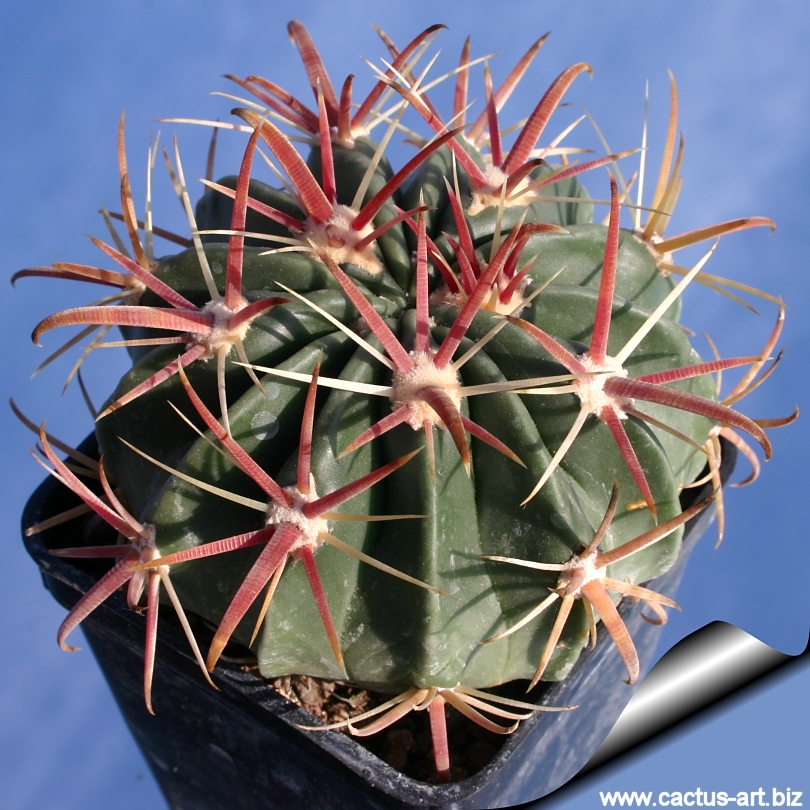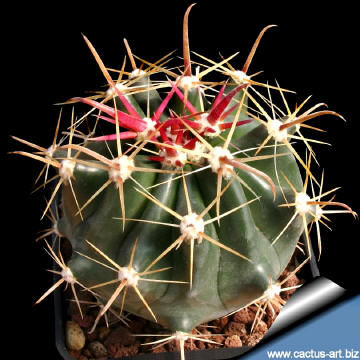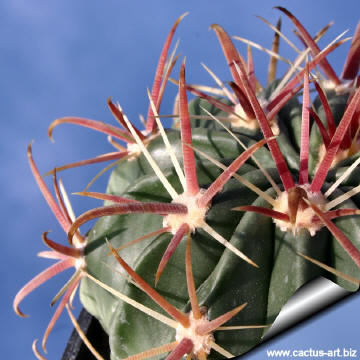|
|
|

F. recurvus v. greenwoodii (or whatever the synonym is)
is a beautiful plant. The young
spines have a
great looking red.
|
|
Description: Ball-shaped or
flat-topped barrel cactus.
Stem: Flattened to spherical (in cultivation), diameter up to
16 cm, 10 cm tall.
Ribs: ± 13, sharp areoles, large with grey to blackish
felt.
Radial spines: 4-5, translucent, cream-yellow up to 2,5 cm long, straight
spreading out the central spines, they have almost no width at all.
Central spines: 1, thick apically bent downward, amber-coloured
to grey-red (bright red when very young), up to 4cm long.
Flowers: Beautiful “glassy” straw-yellow, up
to 6 cm long and 3 cm broad.
Blooming time: Late autumn to early winter but usually only if
the weather is warm and sunny ( need a fair amount of bright sunlight to
form) This species blooms very early, many young plants will bloom when
they reach 10 cm in diameter.
|
 |
 |
|


Advertising
|
|
|
|
Family:
Cactaceae
(Cactus
Family)
Ferocactus recurvus v. greenwoodii (C.
Glass) G. Unger,
Die grossen Kugelkakteen Nordamerikas 229, 1992
Scientific Name: Ferocactus
latispinus (Haworth) Britton & Rose,
The Cactaceae; descriptions and illustrations of
plants of the cactus family 3: 143-144, pl. 16, f. 3, 1922
Common names: Devil's Tongue Barrel, Crow's
Claw Cactus, Candy cactus
Origin: Origin: Oaxaca,
between the cities of Oaxaca and Tehuantepec in the valleys of Totolapan
and Nejapa
Synonyms:
- Cactus latispinus Haw. 1824
- Ferocactus latispinus ssp. spiralis
(Karwinski ex Pfeiffer) N.P. Taylor,
Cactaceae Consensus Initiatives, 5: 13: 1998
- Ferocactus latispinus v. flavispinus
(Haage) Backeberg & F. M. Knuth, Kaktus-ABC
352., 1935
- Ferocactus latispinus v. latispinus
(C. F. Forst.) Backeberg & F. M. Knuth, Kaktus-ABC
352., 1935
- Ferocactus latispinus v. recurvus
(Mill.) Lodé, Cact.
Aventures, cf. Repert. Pl. Succ. (I. O. S.), 27: 29,
without basionym ref; 46: 10 (1995 publ. 1996): 1995
- Ferocactus latispinus v. greenwoodii
(C. Glass) N.P. Taylor,
Bradleya, 2: 27: 1984
- Melocactus latispinus
- Mammillaria latispina
- Cactus recurvus Mill. (Nom illeg.)
1768
- Ferocactus recurvus (Mill.) Borg,
Die grossen Kugelkakteen Nordamerikas: 299: 1992
- Ferocactus recurvus f. flavispinus
(Haage ex C.F. Foerst.) G. Unger,
Die grossen Kugelkakteen Nordamerikas 316, 1992
- Ferocactus recurvus f. spiralis (Karwinski
ex Pfeiffer) G. Unger,
Die grossen Kugelkakteen Nordamerikas 294, 1992
- Ferocactus recurvus v. greenwoodii
(C. Glass) G. Unger,
Die grossen Kugelkakteen Nordamerikas 229, 1992
- Ferocactus recurvus v. latispinus
(Haworth) G. Unger,
Die grossen Kugelkakteen Nordamerikas 302,
1992Bisnaga recurva subsp. latispina (Haw.) Doweld
1999
- Cactus nobilis L. (Nom illeg.)
1771
- Ferocactus nobilis (L..) Britton
& Rose 1922
- Echinocactus nobilis
- Echinocactus cornigerus DC. 1838
- Bisnaga cornigera (DC.) Orcutt
1926
- Ferocactus cylindraceus v. greenwoodiae
(Glass) N.P. Taylor, Bradleya 2: 27., 1984
|
|
|
|
Cultivation: Slow growing
to start but does well under cultivation.
Use very draining soil, water during the aestival growth
cycle (this plant need plenty of water) But needs to be avoided
wetting the bodies of these plants while they are in sunlight. A wet
cactus in the sun light can cause sun burning which can lead to scares
or even fungal infections and death.
Needs full sun. Keep dry at 10°C in winter,
but can tolerate sporadic light frost.Reproduction:
Seeds are the only way of
reproducing.
USE: The "Candy cactus" is
used to make sweets. The middle is cored out and soaked in sugar, then
chopped up and eaten.
Attention: The spines that hook around can graph you if you get
too close. |
|
Photo of conspecific taxa, varieties, forms and
cultivars of F. latispinus.
|
|